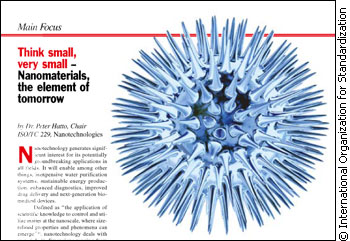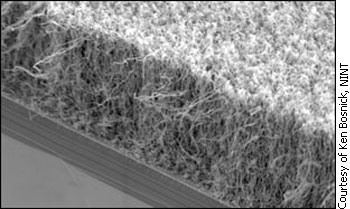But now the ISO is setting its sights on smaller standards,
and creating specifications for the rapidly developing field
of nanotechnology.
The move to create international standards for nanotech
started four years ago, in 2005. Standardization is overseen
by ISO technical committee number 229, which is divided into
four working groups. One deals with terminology and nomenclature
while the second deals with measurement and characterization.
The third examines health, safety and environmental standards
and the fourth, material specifications.
 |
| The ISO recognized the need for nanotech
standards in their February 2009 issue of Focus magazine. |
The process involves not just the ISO, but individual countries
that contribute their own research. Canada acts as convener
for the terminology and nomenclature working group but is
involved with the others as well.
Jennifer Decker, chair of ISO Working Group Two, works with
dimensional metrology at the National Research Council's
Institute for National Measurement Standards. She says the
need for standards arose when nanotechnology started to move
from being a discovery science to a technology. The ability
to measure and characterize objects will enable this change,
she says.
"Nanotechnology is predicted to have a huge economic
impact, so when we look at what we need to know to be able
to use nano to have commercial benefit, the first thing is
we need to be able to make things, so we need to be able
to measure things well enough to make things."
Standards: Good for researcher, good for consumer
Maria DeRosa, an assistant chemistry professor at Carleton
University in Ottawa has encountered the same issues that
Decker describes. She says one of the major problems with
not having standards is, as the field of nanotech grows, it can be difficult to replicate experiments because other labs may not be using comparable materials.
"In chemistry we know that the name is related to the
structure, and the structure is related to the chemistry.
In nano people are just naming things, and especially on
the nanoscale, small differences are going to make a big
difference in the properties," says DeRosa.
She goes on to say that standards will also be useful when
it comes to creating consumer goods and will give consumers
a better awareness of what is in their products. This will
eventually lead to regulations.
 |
| A carbon nanotube film grown at the
National Institute for Nanotechnology. Metrology standards
are being developed for carbon nanotubes, for the purpose
of quality control. |
"Maybe right now it's totally fine, and no one notices
that there's nanosilver on our anti-microbial socks but maybe
once they go though this process of standardizing and figuring
out the properties and toxicity of something like nanosilver,
then maybe they're going to say 'OK, we can't allow this
to be in our socks.'"
Not that simple
But creating standards for nanomaterials
is not as simple as whipping out a ruler, says Peter Hatto,
chairman of ISO technical committee 229.
"You don't take a ruler and measure a particle, you've
got to use some sort of physical properties of that particle."
On top of that, measuring a nanomaterial requires the use
of many different techniques to find all the pertinent information,
says Decker.
| 'You don't take
a ruler and measure a particle, you've got to use some
sort of physical properties of that particle.' |
It is also a long process. Creating a technical specification
takes about two years and requires the consensus of at least
five of the ISO technical committee's participating countries.
A full international standard however, must go through all
of the 160 member countries of ISO, whether or not they participated
in the initial standard. This takes about three years.
And even then, nothing is for sure. Standards are subject
to review every two to three years, depending on whether
they are technical specifications or international standards.
"Standards just provide agreed ways of doing things,
or naming things or describing things or specifying things
and they're not written in stone, they're not the Ten Commandments," says
Hatto.
What's coming down the (nano) tube?
Decker says the development of these standards is happening
very rapidly. ISO technical committees normally meet once
a year, but technical committee 229 is currently on an accelerated
schedule and meets every six months. She says this is because
nanotechnology is recognized as a technology in rapid development,
but with a lack of documentary standards. In order to promote
nanotech as a commercial technology, standards must be established.
He says it really all boils down to knowing what you're
getting.
"Nanomaterials are difficult to evaluate and there's
a need to have confidence in what you're purchasing. No one
buys steel without buying it against a specification. If
you're going to have extensive trade in these materials,
you need specifications that you can rely upon. In any area
of commerce, specifications give you confidence."
Frontpage photo courtesy of Peter Hatto, ISO
|

